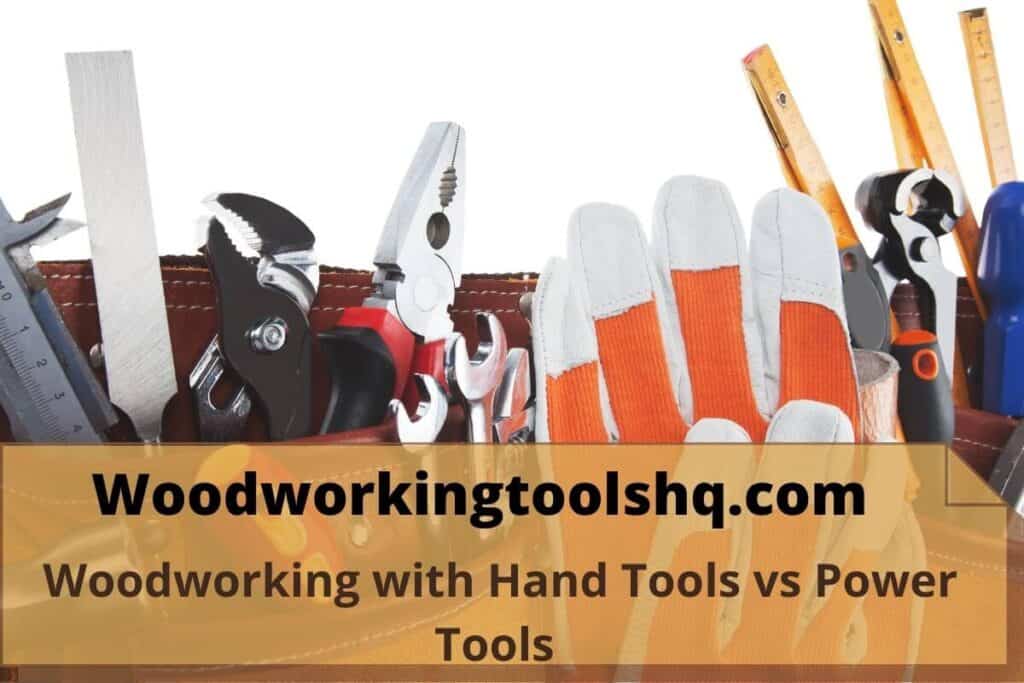When shopping for woodworking tools, the main available options include power tools and hand tools.
Woodworking enthusiasts and DIYers are most of the time faced with the challenge of deciding which is the best between the two.
The answer will depend on your budget, needs, and preferences.
Table of Contents
What’s the Difference between Power Tools and Hand Tools?
Just as the name suggests, hand tools are labor-intensive and require physical energy to use them.
On the other hand, power tools are operated automatically as they have power sources; thus, they function without human intervention.
Power tools require power sources in terms of electricity, air compressor, or battery for their functionality.
Woodworking manual tools feature fewer moving parts, and their design is primarily straightforward.
Unlike their manual counterparts, power tools run more powerfully and efficiently as they feature motors and other electrical mechanisms.
To recap, hand tools depend on human energy for them to operate, while power tools rely on power sources to function.
The Benefits and Drawbacks of Hand Tools
Hand tools have their benefits and drawback and thus is essential to consider all the aspects before deciding whether or not to purchase them.
Benefits of Hand Tools
One of the impressive aspects of owning hand tools is there you wouldn’t have to worry about computerized or mechanical parts breaking.
Hand tools feature fewer moving parts; thus, they tend to be more durable as compared to the power tools, which require regular maintenance.
Woodworking hand tools provider the carpenters with added control over the movement of the tools.
They can quickly move and control following how the user desires.
This aspect makes hand tools perfect for wood carving and for projects that need finely detailed work.
Hand tools require human energy to operate. Thus, they are constantly available for use in various woodworking projects.
The user does not have to worry about power outages or recharging batteries. Hand tools are available for use at any given time.
Hand tools are many convenient thanks to their compact size and lightweight; thus, they are much portable and can be moved from one working station to the other with much ease.
Additionally, they are easy to work with as the user easily lifts them.
Drawbacks of Woodworking Hand Tools
The most obvious limitation of using woodworking hand tools is that they are not as potent compared to the power tools that use electricity for their functionality.
Hand tools may not be ideal for intense woodworking projects as they may not be as effective.
Due to lack of power, hand tools tend to take a much more extended period to complete a woodworking project.
For instance, it may take three or four hits to drive a nail into a piece of lumber with a hammer, but to drive a nail using a nail gun requires one squeeze of the trigger.
Woodworking hand tools tend to be less precise and accurate as compared to power tools.
This is because they depend on the user’s accuracy compared to power tools, which feature a laser beam guide for improved accuracy.
Hand tools move at a slower speed, thus limiting their precision.
The Benefits and Drawbacks of Power Tools
Power tools are commonly used by renowned woodworking experts and enthusiasts and are found in almost all woodworking workshops due to their robust and efficient features.
However, before making your decision, you must put into consideration its benefits and drawbacks.
The Benefits of Woodworking Power Tools
The main advantage that makes most woodworkers go for woodworking power tools is mainly their power.
This is because they are installed with motors which aid in their effective functionality.
They also use a power source, including a battery or electricity, to operate.
Thus they are by far more potent as compared to their manual counterparts.
Woodworking power tools have superior power, which translates to excellent accuracy and precision. This impressive aspect helps to save on time and energy.
Thus you will be able to undertake a massive and challenging woodworking project with much ease and within a short time.
The precision of power tools is attributed to their quick motors and laser beam guides, which help improve accuracy compared to hand tools, which are manual and depend on how accurate the woodworker is.
A vast array of woodworking power tools can handle woodworking projects and tasks that can be challenging while working with hand tools.
A perfect example of this is the jackhammer. Attempting to drive screws or nails with a regular hammer can be an uphill task.
However, the jackhammer can effectively and efficiently take care of this with much ease.
Although most of the power tools tend to be hazardous, they are safer as compared to hand tools.
For instance, cutting down a big tree with a normal manual saw can take much longer and at the same time exposed the user to much peril as compared to the use of a chainsaw.
The Shortcomings of Woodworking Power Tools
There are minimal shortcomings with woodworking power tools:
However, the main ones are dependency on power and prone to failing parts.
For power tools to function, they need a power source, which means if the batteries are depleted, or the power is out, they cannot function.
You will also have to incur the extra cost of electricity and buying new batteries.
Additionally, power tools feature a vast array of mechanical parts; thus, they are more disposed to failure.
It may be costly to repair and maintain your power tools.
Bottom Line
The decision on whether to purchase a hand tool or power tool depends on the woodworking project and the level of precision.
However, it is essential to save on time and do much work within a short period and with increased accuracy, which is why most people prefer power tools over hand tools.





